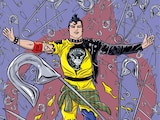While Batman may have been born in 1939, the next two decades would start to shape him into the hero we know and love today, introducing key members of the Bat-Family like Robin, Alfred and the on-again-off-again love of Bruce Wayne’s life, Selina Kyle.
1940s

The Dynamic Duo was born in Detective Comics #38 (April 1940) with the introduction of Batman’s trusty sidekick, Robin the Boy Wonder. Dick Grayson was a circus performer who was orphaned when a gangster murdered his parents. But helpful assistance and a flair for acrobatics wasn’t all the Boy Wonder brought to the Dark Knight’s world. After Batman teamed up with Robin, the tone of Batman’s stories changed. No longer a grim avenger who talked to himself, Batman evolved into a lighthearted father figure trading wisecracks with his young partner.
Originally, Bob Kane agreed to try out Robin for just one issue—DC’s publisher Jack Liebowitz was against the idea of depicting a child constantly at risk in the middle of violence, fighting crooks. But after sales doubled on the first issue to feature the Boy Wonder, Liebowitz sheepishly agreed to keep Robin in future stories.
Batman earned his own self-titled comic book in 1940, while continuing to be featured in Detective Comics. Batman #1 (March 1940) was notable not only for introducing two of his most formidable antagonists, the Joker and Catwoman (here referred to as “the Cat”), but for a story in which Batman used a machine gun to shoot monsters. That story prompted editor Whitney Ellsworth to decree that Batman would no longer kill or use a gun—a crucial tenet of who Batman is that remains a part of his persona today.

Many other key pieces of Batman’s world were introduced in the 1940s. Batman’s home of Gotham City was first referenced by way of its local newspaper, the Gotham Gazette, in Batman #4 (Winter 1940), and the Batcave was implied through a mention of secret underground hangars in Batman #12 in 1942. The first use of the actual term and first appearance of the Batcave was in the 1942 Batman movie serial, years before its first comic book appearance in Detective Comics #83 (January 1944).
But what about the Batmobile? Let’s not forget the Dark Knight possesses the best set of wheels in the DC Universe (if not all of comics). Batman’s first car was actually an ordinary-looking red sedan, but in Batman #5 (Spring 1941), the Batmobile roared into action sporting its own bat-headed battering ram. Sadly, it was driven off a cliff in its very first appearance, but it would return and soon, the Batmobile would be established as a specially built high-powered car designed to aid Batman in his mission.

With all of the crimefighting, you’d have to assume that Bruce Wayne didn’t have much time to tidy up. Batman and Robin declared that they didn’t need a butler, but when Alfred Beagle (later changed to Pennyworth) discovered their secret identities and thwarted a gang of international crooks in Batman #16 (April 1943), he became one of their most loyal allies.
During the 1940s, the tone of the Batman stories grew more fanciful. The Joker became less of a sinister killer and more of a dangerous prankster. In a 1944 story, Batman and Robin journeyed to ancient Rome in their first time-travel adventure. Batman even found an enduring love interest when photojournalist Vicki Vale was introduced in 1948.
1950s
Oh, the ’50s!

Batman stories became somewhat bizarre during the 1950s. The caped-and-cowled hero became an unlikely science fiction star, regularly battling space aliens and robots. In one unusual transformation, he even became Zebra Batman, a radioactive black-and-white-striped menace to Gotham City.
Meanwhile, the Bat-Family was expanded further as several increasingly diverse and whimsical characters were added to the comics, including Batwoman, Batgirl, a magical imp named Bat-Mite, and even Ace the Bat-Hound, a crimefighting dog that wore a mask.
In 1954, a popular book called Seduction of the Innocent linked comic books and juvenile delinquency, leading to calls for censorship. DC’s comics were far tamer than the gory horror comics from other publishers, but there was a cleanup campaign at DC for some of the characters. This led to some unique and occasionally unfortunate results, as Batman gained a Bat-Family and fought villains approved by the Comics Code Authority. Selina Kyle (Catwoman), whose dress featured a slit up to her thigh, was seen as problematic and stopped appearing in Batman stories in 1954. She wouldn’t return in a new story until 1966.

Batman and Superman had been honorary members of the Justice Society of America in the 1940s, but both appeared separately in the same magazine, World’s Finest Comics. It wasn’t until the 1952 story, “The Mightiest Team in the World,” that they joined together in an unofficial partnership to fight crime. In that first story, Batman and Superman fought for the attention of Lois Lane—a competition won by Robin, to the surprise of both heroes.
Look for more on Batman’s long history of heroics tomorrow as part of DC’s Batman 80th anniversary celebration.















